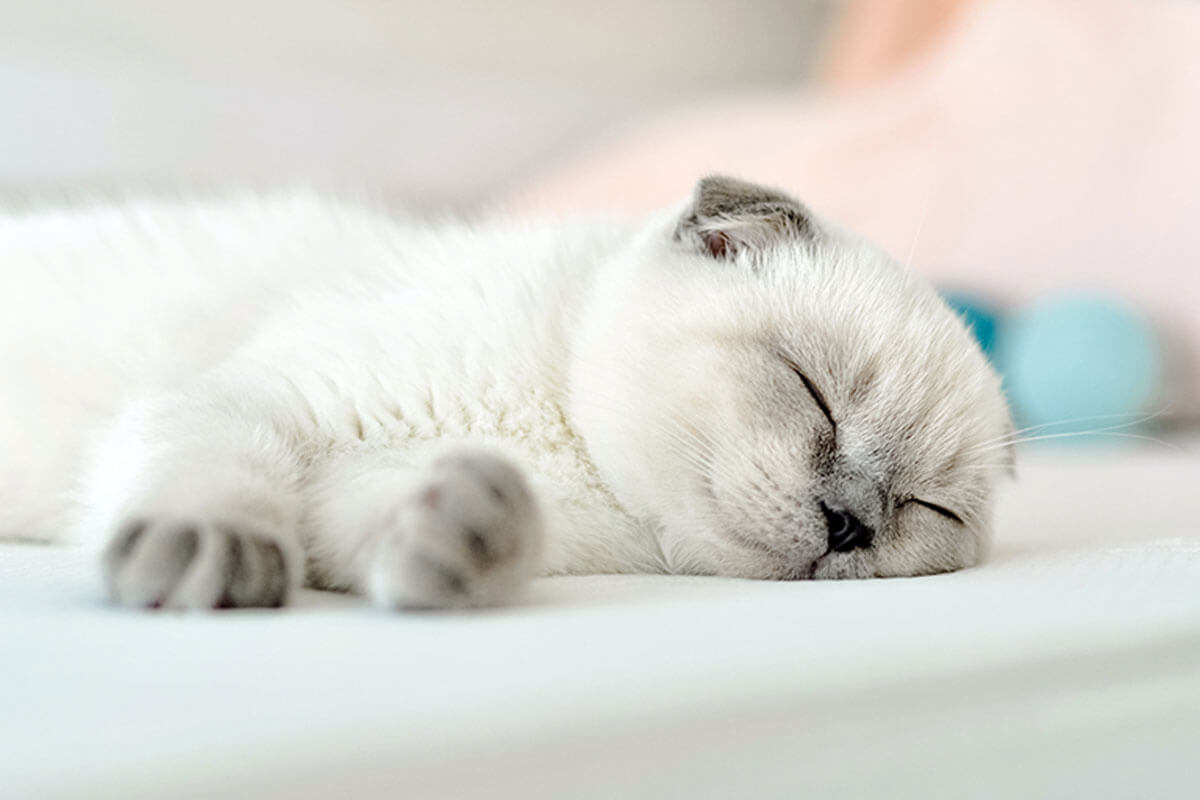How to Tell the Approximate Age of Your Cat


Reviewed and approved by the veterinarian and zootechnician Sebastian Ramirez Ocampo
It’s normal to want to know the approximate age of your cat. However, it isn’t always possible to know it firsthand. Especially when you adopt a cat from a shelter or from the street.
There are some facts that allow you to tell the approximate age of your kitty. Not only so that you can celebrate their birthday, but also so that you can keep better track of their vaccination or deworming schedule. It’s also useful to meet their specific food and care needs, depending on their stage of growth.
Find out the approximate age of your cat
Depending on whether your cat is a kitten, adult, or senior, you’ll need to provide different care. If you don’t know how old your cat is, then keep reading because we’ll tell you how to find out.

Calculate the age if it’s a small kitten
The first thing to know is that a cat is considered a kitten if it’s between the stage of birth and the first year of life. At this stage, they’re quite fragile and shouldn’t go out into the street or be exposed to other cats if they don’t have the complete vaccination schedule, as they can easily catch different diseases and viruses.
During this time, the cat learns how to behave, thanks to the socialization process that it has together with its mother and siblings. Here is how to identify the approximate age of your cat, if you think it’s still a kitten.
- 1 to 10 days old: Cats are dependent on their mother, they don’t get up on their own and don’t open their eyes completely. Their fur is thick and sparse and this is when they’re most fragile.
- 10 to 30 days old: At this time, cats have already opened their eyes and show a clear interest in their environment. They don’t yet coordinate their movements, but try to keep their balance. This is the age at which they begin socialization.
- 30 days: The cats show better development and clear instincts, such as trying to hunt, playing more actively, and starting to groom themselves.
- 45 days of age: The eyes of the kittens acquire their definitive color and the cat’s personality traits can already be distinguished.
- 60 to 90 days: The cats gain weight (800 to 1000 grams – around 2 pounds) and are already very developed, maintain their balance, and are still quite active in playing and hunting. They interact a lot with the people or animals they live with.
- 90 to 120 days: The main change in cats at this stage is in their teeth, which are already definitive and stand out for being very white and shiny.
- 180 to 365 days of age: At this stage, cats are about to reach their adult and definitive size. Their cat behavior is more ingrained and their personality is already clearly distinguishable.
The approximate age of an adult cat
The period in which a cat is considered an adult is quite broad, ranging from 1 to 7 years. At this stage, it has already acquired the skills of the species thanks to the socialization process it should have had. When they reach sexual maturity, females start to go into heat and could become pregnant, while males can start marking.
Once the kittens reach the age of one year, sterilization should be considered to avoid behavior such as that mentioned above. We’ll tell you in detail how to calculate the age of your adult cat.
- The first year of life: The teeth are strong, but they must be well cared for because the food that remains in them is doing its thing. You’ll notice that the shine becomes dull and signs of tartar may appear.
- From 1 to 3 years: The tartar on the teeth increases and this allows you to calculate the age of your furry friend. However, it can be confusing if there’s a habit of brushing or cleaning your pet’s teeth.
- Between 4 and 7 years of age: The teeth will be worn down and the accumulation of tartar is evident. Even the gums begin to pigment.
Calculating the age of an old cat

From 7 to 8 years old, the cat is already considered to be “elderly” and this is evident. In contrast to young cats, elderly cats are less playful, prefer to sleep, and begin to show normal symptoms of deterioration, such as loss of vision, muscle aches, and difficulty walking, among others.
At this age, it’s necessary to offer a complete diet, and an adequate, comfortable, and warm resting space to increase their quality of life.
- 7 to 10 years: The cats are lazy and a change in the pigmentation of their nose and gums is noticed. It will be normal for age-related diseases to appear, so it’s good to keep a continuous check-up.
- 10 to 15 years: Accumulated tartar is evident between the teeth, which will be quite worn down. You’ll see that they become thinner and lose muscle mass.
- 15 to 20 years: Cats that reach this age usually have different diseases or illnesses, become thinner, have gray hair, and look worse for wear. Their nails also grow in an exaggerated way.
Can’t you identify the approximate age of your cat?
If, after these brief descriptions of the physical condition of cats in their different stages, you can’t identify their age, you can always consult a veterinarian. If you have just adopted a cat, no matter where you’ve done it, the best thing to do is to make an appointment with an expert to evaluate different aspects of your cat’s health.
It’s normal to want to know the approximate age of your cat. However, it isn’t always possible to know it firsthand. Especially when you adopt a cat from a shelter or from the street.
There are some facts that allow you to tell the approximate age of your kitty. Not only so that you can celebrate their birthday, but also so that you can keep better track of their vaccination or deworming schedule. It’s also useful to meet their specific food and care needs, depending on their stage of growth.
Find out the approximate age of your cat
Depending on whether your cat is a kitten, adult, or senior, you’ll need to provide different care. If you don’t know how old your cat is, then keep reading because we’ll tell you how to find out.

Calculate the age if it’s a small kitten
The first thing to know is that a cat is considered a kitten if it’s between the stage of birth and the first year of life. At this stage, they’re quite fragile and shouldn’t go out into the street or be exposed to other cats if they don’t have the complete vaccination schedule, as they can easily catch different diseases and viruses.
During this time, the cat learns how to behave, thanks to the socialization process that it has together with its mother and siblings. Here is how to identify the approximate age of your cat, if you think it’s still a kitten.
- 1 to 10 days old: Cats are dependent on their mother, they don’t get up on their own and don’t open their eyes completely. Their fur is thick and sparse and this is when they’re most fragile.
- 10 to 30 days old: At this time, cats have already opened their eyes and show a clear interest in their environment. They don’t yet coordinate their movements, but try to keep their balance. This is the age at which they begin socialization.
- 30 days: The cats show better development and clear instincts, such as trying to hunt, playing more actively, and starting to groom themselves.
- 45 days of age: The eyes of the kittens acquire their definitive color and the cat’s personality traits can already be distinguished.
- 60 to 90 days: The cats gain weight (800 to 1000 grams – around 2 pounds) and are already very developed, maintain their balance, and are still quite active in playing and hunting. They interact a lot with the people or animals they live with.
- 90 to 120 days: The main change in cats at this stage is in their teeth, which are already definitive and stand out for being very white and shiny.
- 180 to 365 days of age: At this stage, cats are about to reach their adult and definitive size. Their cat behavior is more ingrained and their personality is already clearly distinguishable.
The approximate age of an adult cat
The period in which a cat is considered an adult is quite broad, ranging from 1 to 7 years. At this stage, it has already acquired the skills of the species thanks to the socialization process it should have had. When they reach sexual maturity, females start to go into heat and could become pregnant, while males can start marking.
Once the kittens reach the age of one year, sterilization should be considered to avoid behavior such as that mentioned above. We’ll tell you in detail how to calculate the age of your adult cat.
- The first year of life: The teeth are strong, but they must be well cared for because the food that remains in them is doing its thing. You’ll notice that the shine becomes dull and signs of tartar may appear.
- From 1 to 3 years: The tartar on the teeth increases and this allows you to calculate the age of your furry friend. However, it can be confusing if there’s a habit of brushing or cleaning your pet’s teeth.
- Between 4 and 7 years of age: The teeth will be worn down and the accumulation of tartar is evident. Even the gums begin to pigment.
Calculating the age of an old cat

From 7 to 8 years old, the cat is already considered to be “elderly” and this is evident. In contrast to young cats, elderly cats are less playful, prefer to sleep, and begin to show normal symptoms of deterioration, such as loss of vision, muscle aches, and difficulty walking, among others.
At this age, it’s necessary to offer a complete diet, and an adequate, comfortable, and warm resting space to increase their quality of life.
- 7 to 10 years: The cats are lazy and a change in the pigmentation of their nose and gums is noticed. It will be normal for age-related diseases to appear, so it’s good to keep a continuous check-up.
- 10 to 15 years: Accumulated tartar is evident between the teeth, which will be quite worn down. You’ll see that they become thinner and lose muscle mass.
- 15 to 20 years: Cats that reach this age usually have different diseases or illnesses, become thinner, have gray hair, and look worse for wear. Their nails also grow in an exaggerated way.
Can’t you identify the approximate age of your cat?
If, after these brief descriptions of the physical condition of cats in their different stages, you can’t identify their age, you can always consult a veterinarian. If you have just adopted a cat, no matter where you’ve done it, the best thing to do is to make an appointment with an expert to evaluate different aspects of your cat’s health.
All cited sources were thoroughly reviewed by our team to ensure their quality, reliability, currency, and validity. The bibliography of this article was considered reliable and of academic or scientific accuracy.
- Bauhaus, M. (2019). Hill’s. Cat Personalities: Considerations for Your Lifestyle. Recuperado de https://www.hillspet.com/cat-care/new-pet-parent/choosing-the-best-cat-breed-personality
- “Gato”. Autor: Equipo editorial, Etecé. De: Argentina. Para: Concepto.de. Disponible en: https://humanidades.com/gato/. Última edición: 23 de enero de 2023. Consultado: 04 de febrero de 2023
This text is provided for informational purposes only and does not replace consultation with a professional. If in doubt, consult your specialist.








